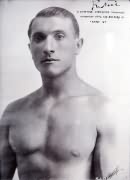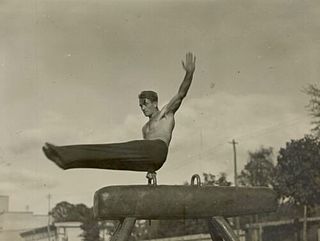
Gymnastics is a type of sport that includes physical exercises requiring balance, strength, flexibility, agility, coordination, artistry and endurance. The movements involved in gymnastics contribute to the development of the arms, legs, shoulders, back, chest, and abdominal muscle groups. Gymnastics evolved from exercises used by the ancient Greeks that included skills for mounting and dismounting a horse, and from circus performance skills.
Artistic gymnastics is a discipline of gymnastics in which athletes perform short routines on different apparatuses. The sport is governed by the Fédération Internationale de Gymnastique (FIG), which assigns the Code of Points used to score performances and regulates all aspects of elite international competition. Within individual countries, gymnastics is regulated by national federations such as British Gymnastics and USA Gymnastics. Artistic gymnastics is a popular spectator sport at many competitions, including the Summer Olympic Games.

Kōhei Uchimura is a retired Japanese artistic gymnast. He is a seven-time Olympic medalist, winning three golds and four silvers, and a 21-time World medalist.

The men's artistic individual all-around event was part of the gymnastics programme at the 1924 Summer Olympics. It was one of nine gymnastics events and it was contested for the sixth time. The competition was held from Thursday, 17 July 1924, to Wednesday, 23 July 1924. Seventy-two gymnasts from nine nations competed. Each nation could send up to 8 gymnasts, up from 6 in previous Games. For the first time since 1904, the scores for individual competitors were used to calculate a team score. The men's artistic individual all-around was won by Leon Štukelj of Yugoslavia. Czechoslovakia's Robert Pražák took silver, while Bedřich Šupčík earned bronze. Both nations were making their debut in the event.

The men's parallel bars event was part of the gymnastics programme at the 1932 Summer Olympics. It was contested for the fifth time after 1896, 1904, 1924, and 1928. The competition was held on Friday, August 12, 1932. Fifteen gymnasts from six nations competed. Each nation was limited to three gymnasts. The event was won by Romeo Neri of Italy, the nation's first victory in the men's parallel bars. István Pelle earned Hungary's first medal in the event with his silver, while Heikki Savolainen similarly earned Finland's first medal with his bronze.

The men's rings or flying rings event was part of the gymnastics programme at the 1932 Summer Olympics. It was contested for the fifth time after 1896, 1904, 1924, and 1928. The competition was held on Friday, August 12, 1932. Fourteen gymnasts from six nations competed. There were 14 gymnasts from six nations. Each nation was limited to three gymnasts. The event was won by George Gulack of the United States, the nation's first medal in the rings since 1904 and second overall. Another American, Bill Denton, took silver. The United States was not able to complete a repeat of its 1904 sweep, however, as Italy's Giovanni Lattuada beat the third American, Richard Bishop, by one-tenth of a point for the bronze.

The men's pommel horse event was part of the gymnastics programme at the 1932 Summer Olympics. It was contested for the fifth time after 1896, 1904, 1924, and 1928. The competition was held on Thursday, August 11, 1932. Ten gymnasts from five nations competed. Each nation was limited to three gymnasts. The event was won by István Pelle of Hungary, the nation's first medal in the pommel horse. Italy also earned its first medal in the event, with Omero Bonoli's silver. Frank Haubold took bronze, the United States' first medal in the event since 1904.

The men's horizontal bar event was part of the gymnastics programme at the 1932 Summer Olympics. It was contested for the fifth time after 1896, 1904, 1924, and 1928. The competition was held on Thursday, August 11, 1932. Twelve gymnasts from six nations competed. Each nation was limited to three gymnasts. The event was won by Dallas Bixler of the United States, the nation's first victory in the men's horizontal bar since 1904 and second overall. Heikki Savolainen and Einari Teräsvirta of Finland tied for second; the two agreed that Savolainen would take silver and Teräsvirta bronze. They were the first medals for Finland in the horizontal bar.

The men's vault or "long horse vaulting" event was part of the gymnastics programme at the 1932 Summer Olympics. It was contested for the fifth time after 1896, 1904, 1924, and 1928. The competition was held on Wednesday, August 10, 1932. Ten gymnasts from four nations competed. Each nation was limited to three gymnasts. The event was won by Savino Guglielmetti of Italy, the nation's first medal in the event. Americans Al Jochim and Ed Carmichael took silver and bronze, respectively.

The men's artistic individual all-around event was part of the gymnastics programme at the 1932 Summer Olympics. It was the eighth appearance of the event, which was established in 1900. The competition was held from Monday, August 8, 1932, to Wednesday, August 10, 1932. Twenty-four gymnasts from five nations competed. Each nation could enter a team of 5 gymnasts; Hungary sent only 4. The event was won by Romeo Neri of Italy, the nation's first victory in the event since 1920 and fourth overall. István Pelle of Hungary took silver and Heikki Savolainen of Finland earned bronze; it was the first medal in the event for each nation.

Danell Johan Leyva is a Cuban American former gymnast who competed for the United States. He is the 2012 Olympic individual all-around bronze medalist and 2016 Olympic parallel bars and horizontal bar silver medalist. He is also the 2011 US national all-around gold medalist and the 2011 world champion on the parallel bars. With a combined total of 8 Olympic and World Championships medals, Leyva is the second most decorated American male gymnast after Paul Hamm.

A perfect 10 is a score of 10.000 for a single routine in artistic gymnastics, which was once thought to be unattainable—particularly at the Olympic Games—under the code of points set by the International Gymnastics Federation (FIG). It is generally recognized that the first person to score a perfect 10 at the Olympic Games was Romanian Nadia Comăneci, at the 1976 Games in Montreal. Other women who accomplished this feat at the Olympics include Nellie Kim, also in 1976, Mary Lou Retton in 1984, Daniela Silivaș and Yelena Shushunova in 1988, Lu Li and Lavinia Miloșovici in 1992. The first man to score a perfect 10 is considered to be Alexander Dityatin, at the 1980 Olympics in Moscow.

Samuel Anthony Mikulak is a retired American artistic gymnast. He is a six-time U.S. national all-around champion, the 2018 World bronze medalist on high bar, and a three-time Olympian. He is also an eight-time NCAA champion, winning the team, individual all-around and several individual event titles at the 2011, 2013 and 2014 NCAA Men's Gymnastics championships.

Oleg Yuriyovych Verniaiev is a Ukrainian artistic gymnast. He is the 2016 Olympic parallel bars champion and individual all-around silver medalist. Verniaiev is also the 2014 World parallel bars champion, the 2015 European individual all-around champion and the 2017 European individual all-around champion.

Nikita Vladimirovich Nagornyy is a Russian artistic gymnast and two-time Olympian, representing Russia in 2016 and ROC in 2020. He was part of the teams who won gold at the 2020 Olympic Games and 2019 World Championships and silver at the 2016 Olympic Games and 2018 World Championships.

Boris Gregorka was a Slovenian gymnast, competing for Yugoslavia. He won a bronze medal at the 1928 Summer Olympics. After retiring from competitive career, he was the coach of a double Olympic gold medallist Miroslav Cerar.
Ya'akov Levi is an Israeli former Olympic gymnast.

Yul Kyung-Tae Moldauer is an American artistic gymnast. He is the 2017 U.S. national all-around champion and the 2017 World bronze medalist on floor exercise. He represented the United States at the 2020 Summer Olympics and was a member of the bronze medal winning team at the 2023 World Championships.
Daiki Hashimoto is a Japanese artistic gymnast. Widely regarded as the successor of Kohei Uchimura, he won two gold medals at the 2020 Summer Olympics, in all-around and horizontal bar, as well as a silver in team. At the world championships, he has also won 3 golds, 5 silvers, and 1 bronze.

John Brody Malone is an American artistic gymnast. He represented the United States at the 2020 and 2024 Summer Olympics and is a three-time United States national all-around champion. On horizontal bar, he is the 2021 World Championships bronze medalist and the 2022 World Champion. He is a ten-time NCAA National Champion. In June 2024, he was named the U.S. Olympic team.

















